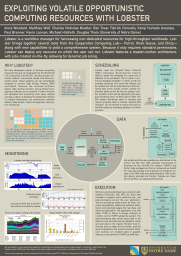The software may be downloaded here:
http://www.cse.nd.edu/~ccl/software/download
This minor release adds several features and bug fixes. Among them:
- [Makeflow] Several enhancements in garbage collection. (Nick Hazekamp)
- [Makeflow] Better task state handling when recovering execution log. (Nick Hazekamp)
- [Parrot] Correct handling of multi-threaded programs. (Patrick Donnelly)
- [Parrot] Adds parrot_mount, to set arbitrary mount points while parrot is executing. (Douglas Thain)
- [Parrot] Add --fake-setuid option, for executables that request setuid. (Tim Shaffer)
- [Parrot] Update cvmfs uri to new convention. (Jakob Blomer)
- [Parrot] Add --whitelist to restrict filesystem access. (Tim Shaffer)
- [Parrot] Make special file descriptors invisible to tracee. (Patrick Donnelly)
- [Resource Monitor] Compute approximations of shared resident memory. (Ben Tovar)
- [Resource Monitor] Remove resource_monitorv for static binaries. resource_monitor now handles all cases. (Ben Tovar)
- [Resource Monitor] Working directories are not tracked by default anymore. Use --follow-chdir instead. (Ben Tovar)
- [Umbrella] Support for curateND. (Haiyan Meng)
- [Umbrella] Support for installing software from package managers. (Haiyan Meng)
- [Work Queue] Adds option -C to read a JSON configuration file. (Ben Tovar)
- [Work Queue] Several bug fixes regarding task/workflow statistics. (Ben Tovar)
- [Work Queue] Master's shutdown option now correctly terminates workers. (Ben Tovar)
- [Work Queue] Adds --sge-paremeter to ./configure script to personalize the sge_submit_workers script. (Ben Tovar)
- [Work Queue] Adds the executable disk_allocator, to restrict disk usage at the workers. (Nate Kremer-Herman)
Incompatibility warnings:
- Workers from this release do not work correctly with masters from previous releases.
Thanks goes to the contributors for many features, bug fixes, and tests:
- Jakob Blomer
- Neil Butcher
- Patrick Donnelly
- Nathaniel Kremer-Herman
- Nicholas Hazekamp
- Peter Ivie
- Kevin Lannon
- Haiyan Meng
- Tim Shaffer
- Douglas Thain
- Ben Tovar
- Mathias Wolf
- Anna Woodard
Please send any feedback to the CCTools discussion mailing list:
http://ccl.cse.nd.edu/software/help/
Enjoy!
































